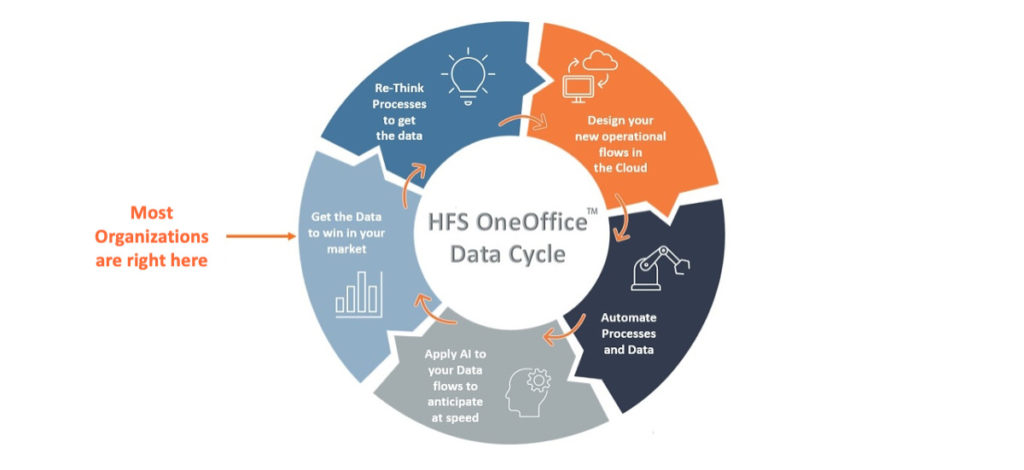Applications are dead, data is your North Star in the journey to Cloud Native.
As your enterprise fully adopts the cloud, you must move past standalone applications and focus on data as the change agent for delivering business and customer value. Any CIOs doubting this should ask, “If applications were critical, wouldn’t cloud providers like Microsoft, Amazon, and Google offer application SLAs [service level agreements] rather than limit their SLAs to only their cloud service elements?”
Interactions with services providers and enterprises helped form HFS’ opinion that too many cloud strategies are over-rotating on migrating and modernizing applications without addressing the scope of their data needs. As a result, efforts to adopt the cloud for cost savings or access to new functionality only succeed in moving the technology debt and “whack a mole” challenges into a new paradigm.
At HFS’ recent HFS OneOffice™ Digital Symposium, Alex Rinke (CEO of Celonis) echoed this view when he commented to the audience:
“While the cloud is the infrastructure for the modern business, data is core to the DNA. Yet, too often, businesses are missing two key aspects of their data strategy; to be successful, data must be real-time and must drive action, not only insights.”
Business and technology leaders must prioritize data. Focusing on applications while ignoring the work required to build a data strategy is akin to building a house by starting with the walls. Without assessing how data is (and isn’t) supporting the business’ objectives and taking the time to address deficiencies caused by multiple sources of the truth, a firm endangers its long-term success with a lack of shared insights and poor analytics.
Many digital transformation projects are still framing problems in the distributed computing mindset. The foundation for your cloud migration strategy is to understand where your data is today, what needs to be accessible and by who, and how it is structured, managed, and secured. Often this will require you to consider Cloud Native data solutions like PostgreSQL, MongoDB, NoSQL, and BigQuery.
As illustrated in the HFS OneOffice™ Data Cycle, in will need to update your thinking to bring in new design, coding, and integration skills. Evolving your data strategy as cloud first will also require you to adopt tools like Low Code for the business to operationalize and reconfigure as needs change. Finally, you must plan how you embed artificial intelligence (AI) to augment how the solution contextualizes and delivers insights to the business and individual levels.

Source: HFS Research, 2021
Companies willing to walk away from their “duct-tape” strategies of implementing connectors, APIs, and cross-application integrations will create more value and better experiences. By prioritizing data over applications, your teams can develop services which deliver significantly more value internally and externally. To become Cloud Native, you must get your firm’s data strategy right, reduce off-the-shelf and SaaS apps, and focus on how data and AI can facilitate the modernization of workloads and business processes.
Nearly half of the respondents from HFS’ recent survey of business and technology leaders from Global 2000 firms responded that database-related workloads are the top targets for cloud migration. Responses in Exhibit 2 illustrate the prioritization of accessing and leveraging insights from data, not applications.

Sample: n=801
Source: HFS Pulse 2021, Global 2000 Survey
Our survey of Global 2000 firms highlights data workloads are the priority. As such, HFS stresses data migration is more than “lift and shift” as replacing applications with microservices prioritizes data integrity, consistency, and securing data. This design change requires data to be decoupled to promote agility and optimization at a service level. Thus, multiple data stores and workloads must operate in a sustainable manner to deliver actionable insights. Both AI and automation tools will be crucial.
By defining your data strategy in terms of cloud architectures, you’ll be positioned to optimize which applications you keep and which solutions you discard. You data should dictate your applications modernization strategy and is essential to deciding how your firm will adopt and design the consumption of data at scale. Reducing the dependance on third party applications is the best way to manage cloud costs, decreasing the spend on non-core applications which are no longer needed. The end game isn’t about more applications; it’s about using modern tools to optimize workloads to deliver data in context, in real-time.
The journey to become Cloud Native begins and ends with data. Thus, the onus is on your firm’s leadership to put the work into defining (or re-defining) how you manage your data, what insights are core to delivering value, and how to deliver data in context to the teams and roles that need data to drive profitable actions.
Moving to the cloud offers many advantages for people, processes, technologies, and culture. The cloud allows for “born in brick and mortar” to compete with “born in the cloud” companies. The cloud brings modern tools for business and technology to co-create solutions based on workflows and data—delivering these at scale to create value shared by the business and its customers. Make no mistake, it’s the data that is the foundation of your business, not its applications.
Register now for immediate access of HFS' research, data and forward looking trends.
Get StartedIf you don't have an account, Register here |
Register now for immediate access of HFS' research, data and forward looking trends.
Get Started